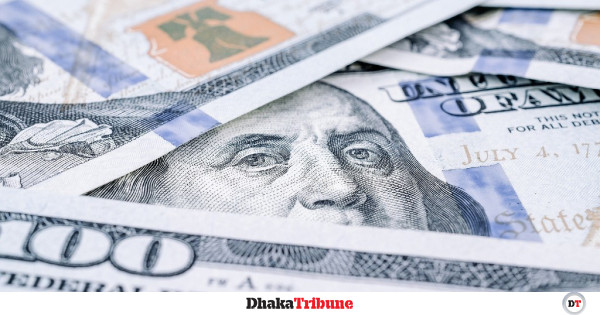Despite the global crisis, Bangladesh has reportedly performed better than neighbouring India and Pakistan in foreign exchange reserve management, th
Despite the global crisis, Bangladesh has reportedly performed better than neighbouring India and Pakistan in foreign exchange reserve management, the countries’ central banks have said.
Last month’s data indicates that while the forex reserves of India and Pakistan declined, Bangladesh was the only exception, although the amount is small.
According to the latest data from Bangladesh Bank, the country’s foreign exchange reserves stood at $32.22 billion on January 31. On February 15, foreign exchange reserves increased to $32.6 billion and have been increasing since then as well.
In this regard, the bank officials said recently the exports and remittances have returned to a positive trend, while imports had decreased due to various regulatory measures. As a result, foreign exchange reserves are gradually increasing.
Bangladesh Bank spokesperson Mezbaul Haque noted as Ramadan and Eid-ul-Fitr were ahead, the remittance flow would increase in the next few months as well.
Haque estimated that the forex reserves would come into a comfortable position, but added that things would not change overnight.
Meanwhile, according to a prediction by the International Monetary Fund (IMF), at the end of the current fiscal year, Bangladesh’s foreign exchange reserves will decrease to $30 billion. However, IMF said the amount would increase continuously from the next financial year.
The report added that at the end of the financial year 2026-27, the country’s reserves would exceed $50 billion for the first time. The organization has predicted these outcomes in a report on Bangladesh’s economy based on various indicators.
Meanwhile, to keep the economy in check, Bangladesh Bank continued to sell dollars almost every day. As authorities have increased vigilance to control the main enemy of remittances, the Hundi, the overall dollar supply situation has improved.
According to data from Bangladesh Bank, export earnings were $32.45 billion or an average of $4.64 billion per month in the seven months till January of the current fiscal year.
Meanwhile, in November, December, and January, exports averaged $5.2 billion per month. Remittance and expatriate income increased to $1.96 billion in January, while it was below $1.7 billion in December.
The first ten days of February saw $640 million in remittances, and hence, it is expected to increase further this month.
Besides, by implementing several measures, such as increasing the LC margin up to 100%, and enhancing supervision, the import expenditure has been reduced by 2.15% to $38.13 billion in the six months till December. As a result, the overall strain on the foreign exchange reserves is gradually decreasing.
According to the information provided by the Bangladesh Bank, after paying the import bill to the Asian Clearing Union (ACU) on January 9, Bangladesh’s foreign currency reserves stood at $32.52 billion.
Although the reserves had fallen below $33 billion after that day, the Bangladesh Bank officials have shown prudence in managing the reserves in a month.
Meanwhile, India’s forex reserves saw the biggest decline in the past 11 months last week.
In this regard, Indian news outlet Times of India published a report that said the fall was likely due to the fact that the Reserve Bank of India is selling dollars to keep the value of the Rupee stable.
The latest data released by the Reserve Bank of India on Friday showed that the country’s reserves fell by $8.3 billion and now stand at $566.95 billion. This is the biggest decline since April last year.
In October last year, India’s foreign exchange reserves stood at a record of $645 billion dollars, but as the central bank continued to use the dollar to support the local currency, the reserves continued to dwindle.
And the situation worsened after US-based Hindenburg Research accused the Adani Group of share manipulation.
Bloomberg has also reported that the Reserve Bank of India’s update on Friday said that the country’s reserves fell by $8.3 billion to $566.95 billion as of February 10, the lowest since April 2022.
In late January, Adani Group’s share price plummeted following a sensational report by New York-based investment research firm Hindenburg Research on corruption and fraud, which has put the rupee under pressure.
Meanwhile, according to the data from the State Bank of Pakistan on February 3, the foreign exchange reserves of Pakistan, which is in a severe financial crisis, decreased by $170 million, and now stand at $2.9 billion.
According to the Pakistani news outlet, The Express Tribune, Pakistan will have to repay around $22 billion in foreign debt and interest over the next 12 months. Otherwise, the country will default.
Pakistan’s current debt outweighs the amount of money it is expected to receive in the coming years. As per the State Bank of Pakistan (SBP), the country has to settle a debt of $21.95 billion in a year, which includes $19.34 billion in principal debt and $2.60 billion in interest on that debt.
Analysis of the data shows that Pakistan has to pay $3.95 billion dollars within a month. The country has to pay $4.63 billion dollars in the next three months and $13.37 billion dollars in the last eight months of the year.
In the period from February 2023 to June 2026, Pakistan will be obligated to repay a total of $80 billion in foreign debt.
www.dhakatribune.com
